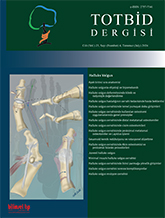
Hallux valgus (HV) surgery is one of the most frequently applied treatment methods in foot and ankle surgery practice. The incidence of complications that may occur after hallux valgus surgery is reported to be between 10 and 55%. These complications can be listed as recurrence of the previous deformity, infection, neuroma, symptomatic fixation materials, movement limitation, malunion, nonunion, avascular necrosis, transfer metatarsalgia, hallux varus and uncontrallable pain severe enough to require surgical intervention. Recurrence is the most common complication among the listed and its incidence is reported to be between 3% and 16%.Complications related to hallux valgus surgery can be prevented with an appropriate pre-operative surgical planning; pre-operative evaluation of patient-related factors such as age and bone quality; surgeons expertise, post-operative rehabilitation protocol and limiting patient expectations to realistic goals. Regardless of the underlying cause, complaints are first tried to be controlled with conservative treatment in all patients. For this purpose, analgesics, offloading of the painful joints or metatarsal heads, orthoses, shoe modifications, and stretching exercises can be used. If the toe can not function properly and/or limit daily activities because of the pain; revision surgery is warranted.